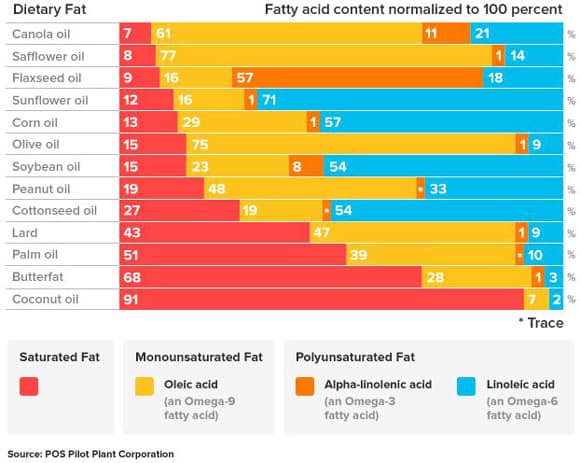Blogpost: Get in Line!! Balancing Your Omega Intake for Optimal Health
By SBG Performance & Nutrition
What you’re in for: 5 minutes looking at the health benefits of having a balanced amount of Essential Fatty Acids and the potential dangers of not adhering to this.
We (humans) have evolved up until, historically speaking, recently with a diet comprising of a nice balance of omega 3 & 6 fatty acids. About 140 years ago everything changed and since then we have seen deaths by chronic disease skyrocket past anything we as a species has ever known.
What are the omega fats and why is getting a good balance of them essential for optimal health? Lets take a closer look.
Omegas 3 & 6 are essential polyunsaturated fatty acids which our bodies lack the enzymes to produce, which means they must be obtained through our diet. They have many functions within the body and are important components of cell membranes and omega 3 in particular has been shown to improve levels of triglycerides (fat) in the blood, depression, asthma and ADHD. It also enhances your immune system and lowers the risk of chronic diseases.
Throughout our history humans have consumed omega 3 rich food sources such as marine life, wild game, blubber from seals and whales, coconuts and unpasteurised dairy, whilst our intake of omega 6 rich sources like nuts, seeds and plant oils was relatively low. This gave us an omega 3:6 ratio of around 1:1. Ever since the industrial revolution around 140 years ago and the emergence of the vegetable oil industry, our omega 6 intake has shot up so that the average ratio of omega 3:6 in industrialised countries is now between 1:10 and 1:20 with some estimates being as high as 1:25.
But why does this matter?
Well, having an even balance of omega 3:6 in our diet is conducive for having a non-inflammatory state within our bodies. A small amount of inflammation is good. It protects us from disease and injury and it is acute inflammation that helps us to adapt to exercise and become stronger. The problem occurs when we suffer from chronic inflammation. This puts our bodies in a state of perpetual disrepair where it is always trying to heal itself.
How does this apply to our omegas?
Omega 6 is classed as pro-inflammatory, whilst omega 3 is neutral or non-inflammatory. Having a diet with balanced levels of the two is contributory to good health and a reduced risk of chronic diseases such as heart disease, metabolic syndrome, diabetes, arthritis, Alzheimer’s and many types of cancer.
The fact that people are consuming less omega 3 rich sources than ever before is made worse by the fact that we are consuming much more omega 6’s as well. Since vegetable oil was first marketed as a cheap, healthy alternative to ‘evil’ saturated fats from things like grass fed animals, butter and coconut oil the rate of deaths from chronic diseases has gone through the roof, so much so that 40% of all deaths each year in the US are from heart disease.
So the million dollar question is; How can I bring my omega 3 to 6 balance in line?
Luckily for us optimising our essential fatty acid (EFA) intake is relatively simple.
The first port of call is to reduce the amount of omega 6 fats in the diet. This is very easily done by simply not cooking with processed oils such as soy bean and safflower. Use coconut or butter fat to cook with instead. The relatively high levels of saturated fat in these means that the oil is far more resistant to heat and stable to cook with.
Here is a graph showing some of the most prominent oils used in todays society. You should avoid all of the ones with a high proportion of omega 6 (blue indicator)
Photo: POS Pilot Plant Corporation
Avoiding processed foods in general will help to lower your omega 6 intake. Even some ‘health’ foods such as soy beans are high in omega 6 and should be avoided.
Although nuts and seeds have a relatively high omega 6 content they have plenty of other health benefits and are absolutely fine to eat.
The second approach is to increase your levels of omega 3 by consuming natural sources rich in essential fatty acids. Eating oily fish 1-3 times per week will get you well on your way to increasing your omega 3 levels. Salmon is a particularly good source. Wild caught fish is the best option but even farmed fish is better than none at all. Omega 3 enriched eggs are another good source.
If you can afford organic meat then I would recommend opting for it over grain fed. Animals fed on grain will have a high amount of soy bean and corn in their diets which alters the fatty acid profile of the meat making it much higher in omega 6 than it should be.
So there you have it…
High omega 6 in diet = Bad
Even amount of omega 3 & 6 in diet = Good



Balance36
10/04/2015 at 05:34Thanks for taking up the issue. It really is something we need to understand as we’ve managed to get over 600% more omega-6 in us just in the past few generations. You gave a good overview, I’d also recommend looking for the oils you mentioned in dressings (or just use olive oil + vinegar). And then mention that organic doesn’t always mean grass fed (organic grains and soy), but they are required to have access to pastures. Finding a meat that says grass fed can be tough, but is worth it!
admin
15/04/2015 at 15:09Thanks for your comment, Balance36. Those are very good points that I overlooked. Most of the meat in the UK and Australia is grass fed, I believe that the real problem is in the US where the majority of animals are grain fed.